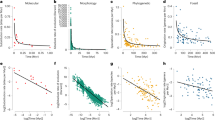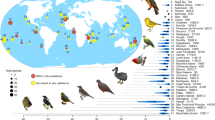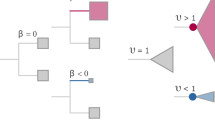Abstract
In recent years, strikingly consistent patterns of biodiversity have been identified over space, time, organism type and geographical region1,2. A neutral theory (assuming no environmental selection or organismal interactions) has been shown to predict many patterns of ecological biodiversity2,3. This theory is based on a mechanism by which new species arise similarly to point mutations in a population without sexual reproduction. Here we report the simulation of populations with sexual reproduction, mutation and dispersal. We found simulated time dependence of speciation rates, species–area relationships and species abundance distributions consistent with the behaviours found in nature1,2,3,4,5,6,7,8,9,10,11,12,13. From our results, we predict steady speciation rates, more species in one-dimensional environments than two-dimensional environments, three scaling regimes of species–area relationships and lognormal distributions of species abundance with an excess of rare species and a tail that may be approximated by Fisher’s logarithmic series. These are consistent with dependences reported for, among others, global birds4 and flowering plants5, marine invertebrate fossils6, ray-finned fishes7, British birds8,9 and moths10, North American songbirds11, mammal fossils from Kansas12 and Panamanian shrubs13. Quantitative comparisons of specific cases are remarkably successful. Our biodiversity results provide additional evidence that species diversity arises without specific physical barriers6,11,14. This is similar to heavy traffic flows, where traffic jams can form even without accidents or barriers15.
This is a preview of subscription content, access via your institution
Access options
Subscribe to this journal
Receive 51 print issues and online access
$199.00 per year
only $3.90 per issue
Buy this article
- Purchase on Springer Link
- Instant access to full article PDF
Prices may be subject to local taxes which are calculated during checkout



Similar content being viewed by others
References
Rosenzweig, M. L. Species Diversity in Space and Time (Cambridge Univ. Press, 1995)
Hubbell, S. P. The Unified Neutral Theory of Biodiversity and Biogeography (Princeton Univ. Press, 2001)
Volkov, I., Banavar, J. R., Hubbell, S. P. & Maritan, A. Patterns of relative species abundance in rainforests and coral reefs. Nature 450, 45–49 (2007)
Preston, F. W. Time and space and the variation of species. Ecology 41, 611–627 (1960)
Schmida, A. & Wilson, M. V. Biological determinants of species diversity. J. Biogeogr. 12, 1–20 (1985)
Alroy, J. et al. Phanerozoic trends in the global diversity of marine invertebrates. Science 321, 97–100 (2008)
Moyle, P. B. & Cech, J. J. Fishes: An Introduction to Ichthyology 5th edn (Benjamin Cummings, 2003)
Gibbons, D. W., Reid, J. B. & Chapman, R. A. The New Atlas of Breeding Birds in Britain and Ireland: 1988–1991 (Poyser, 1993)
Gregory, R. D. Species abundance patterns of British birds. Proc. R. Soc. Lond. B 257, 299–301 (1994)
Williams, C. B. Patterns in the Balance of Nature and Related Problems of Quantitative Biology (Academic, London, 1964)
Klicka, J. & Zink, R. M. The importance of recent ice ages in speciation: a failed paradigm. Science 277, 1666–1669 (1997)
Rosenzweig, M. L. Tempo and mode of speciation. Science 277, 1622–1623 (1997)
D’Arcy, W. E. Flora of Panama: Checklist and Index Vols 1–4 (Missouri Botanical Garden, 1987)
Irwin, D. E., Bensch, S., Irwin, J. H. & Price, T. D. Speciation by distance in a ring species. Science 307, 414–416 (2005)
Nagel, K. & Schreckenberg, M. A cellular automaton model for freeway traffic. J. Phys. I 2, 2221–2229 (1992)
Doebelli, M., Dieckmann, U., Metz, J. A. J. & Tautz, D. What we have also learned: adaptive speciation is theoretically plausible. Evolution 59, 691–695 (2005)
Gavrilets, S. “Adaptive speciation”—it is not that easy: a reply to Doebeli et al. Evolution 59, 696–699 (2005)
Payne, R. J. H. & Krakauer, D. C. Sexual selection, space, and speciation. Evolution 51, 1–9 (1997)
Doebeli, M. & Dieckmann, U. Speciation along environmental gradients. Nature 421, 259–264 (2003)
Hoelzer, G. A., Drewes, R., Meier, J. & Doursat, R. Isolation-by-distance and outbreeding depression are sufficient to drive parapatric speciation in the absence of environmental influences. PLoS Comput. Biol. 4, e1000126 (2008)
Higgs, P. G. & Derrida, B. Stochastic models for species formation in evolving populations. J. Phys. A 24, L985–L991 (1991)
Kondrashov, A. S. & Shpak, M. On the origin of species by means of assortative mating. Proc. R. Soc. Lond. B 265, 2273–2278 (1998)
Lewontin, R., Kirk, D. & Crow, J. Selective mating, assortative mating and inbreeding: definitions and implications. Eugen. Q. 15, 141–143 (1968)
Dobzhansky, T. Genetics and the Origin of Species (Columbia Univ. Press, 1937)
Gavrilets, S., Li, H. & Vose, M. D. Patterns of parapatric speciation. Evolution 54, 1126–1134 (2000)
Ricklefs, R. E. Estimating diversification rates from phylogenetic information. Trends Ecol. Evol. 22, 601–610 (2007)
Fisher, R. A., Corbet, A. S. & Williams, C. B. The relation between the number of species and the number of individuals in a random sample of an animal population. J. Anim. Ecol. 12, 42–58 (1943)
Bar-Yam, Y. Dynamics of Complex Systems (Perseus, 1997)
Sugihara, G., Bersier, L.-F., Southwood, T. R. E., Pimm, S. L. & May, R. M. Predicted correspondence between species abundances and dendrograms of niche similarities. Proc. Natl Acad. Sci. USA 100, 5246–5251 (2003)
Greenwood, P. J. & Harvey, P. H. The natal and breeding dispersal of birds. Annu. Rev. Ecol. Syst. 13, 1–21 (1982)
Acknowledgements
We acknowledge internal support by the New England Complex Systems Institute. M.A.M.d.A. and E.M.B. acknowledge financial support from the Fundação de Amparo à Pesquisa do Estado de São Paulo and the Conselho Nacional de Desenvolvimento Científico e Tecnológico, and L.K. from the Marine Management Area Science Programof Conservation International and the Gordon and Betty Moore Foundation.
Author information
Authors and Affiliations
Corresponding author
Supplementary information
Supplementary Figures
This file contains Supplementary Figures 1-2. (PDF 271 kb)
Rights and permissions
About this article
Cite this article
de Aguiar, M., Baranger, M., Baptestini, E. et al. Global patterns of speciation and diversity. Nature 460, 384–387 (2009). https://doi.org/10.1038/nature08168
Received:
Accepted:
Issue Date:
DOI: https://doi.org/10.1038/nature08168
This article is cited by
-
Dynamics of rapid evolution on the basis of phenotypic adaptation and ecological opportunities
Evolutionary Intelligence (2024)
-
Mito-nuclear selection induces a trade-off between species ecological dominance and evolutionary lifespan
Nature Ecology & Evolution (2022)
-
Systematics, species diversity and new taxa of mesozooplankton in the West Pacific Ocean and its marginal seas: a brief compilation of monographs in China
Acta Oceanologica Sinica (2018)
-
Solution of the spatial neutral model yields new bounds on the Amazonian species richness
Scientific Reports (2017)
-
Diploid versus haploid models of neutral speciation
Journal of Biological Physics (2016)
Comments
By submitting a comment you agree to abide by our Terms and Community Guidelines. If you find something abusive or that does not comply with our terms or guidelines please flag it as inappropriate.



